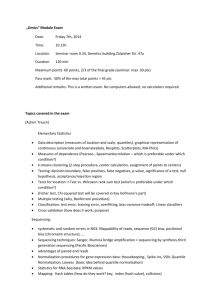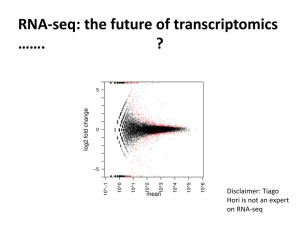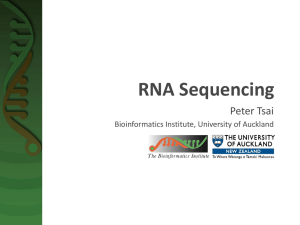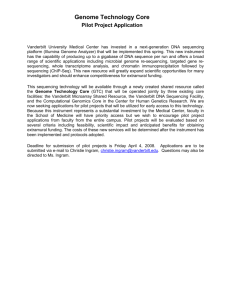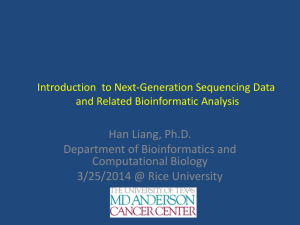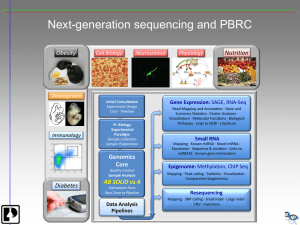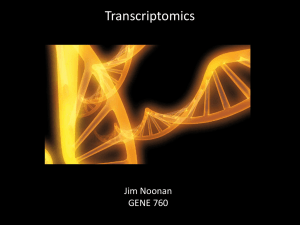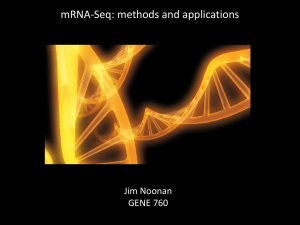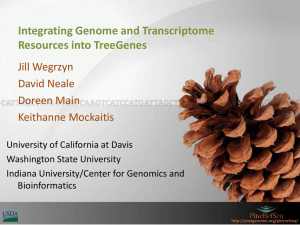"Big Data" from RNA
advertisement
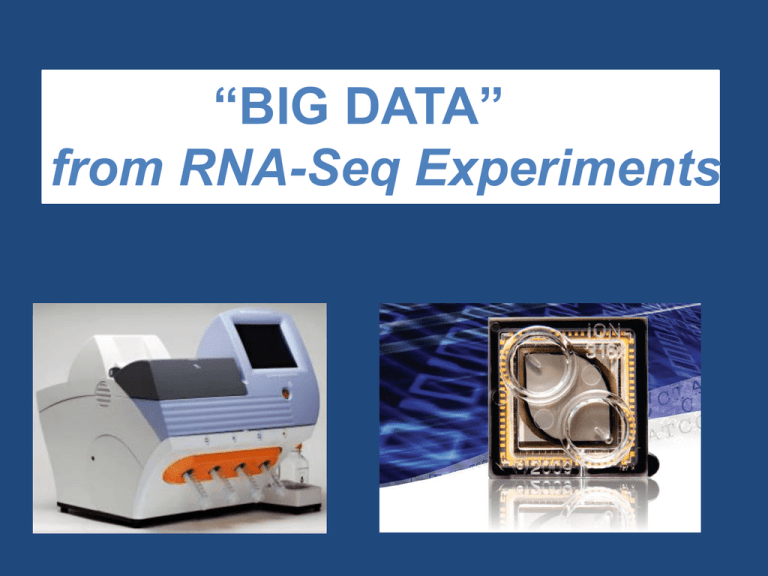
“BIG DATA” from RNA-Seq Experiments Significance of RNA-Seq Approaches Reveals which genes are expressed and the levels at which they are expressed; a technique for the “post-genomic” era Of huge importance for biomedicine, toxicology, environmental biology, and basic research “Whole Genome Analysis: When Each Patient is a Big Data Problem” “ … spectacular opportunities and immense challenges presented by the dawning era of "Big Data" in biomedical research … (NIH call for proposals) Review: “Central Dogma of Molecular Biology” DNA -> RNA -> Protein (Way more complex!) http://biology200.gsu.edu/houghton/ 4595%20'04/figures/Lecture1/dogma. gif Alternative Splicing: Splice Variants or Isoforms http://www.nature.com/scitable/content/ne0000/ne0000/ne0000/ne0000/95777 /DNA_alternative_splicing_LARGE_2.jpg WHAT IS BIG DATA ??? 1. Gartner. In 2001: Three-fold definition encompassing the “three Vs”: Volume, Velocity and Variety. sometimes includes a fourth V: veracity, to cover questions of trust and uncertainty. 2. Oracle. Big data is the derivation of value from traditional relational database-driven business decision making, augmented with new sources of unstructured data. 3. Intel: a median of 300 terabytes of data a week. 4. Microsoft. applying serious computing power— machine learning and artificial intelligence— To massive and often complex sets of information.” 5. The Method for an Integrated Knowledge Environment : not a function of the size of a data set but its complexity; high degree of permutations and interactions within a data set. 6. NIST : data which exceed(s) the capacity or capability of current or conventional methods and systems. http://www.technologyreview.com/view/519851/the-big-data-conundrum-how-to-define-it/ BIG DATA in BIOLOGY (Sequencing) : A BIG Problem ~150 GB per human genome/transcriptome “The Big Challenges of Big Data”: http://www.nature.com/nature/journal/v498/n7453/full/498255a.html The “Science Question” in Our Lab: How do cells in the nervous system acquire and identity … …. and maintain an identity on the face of a changing environment? Genetic Perturbations: Embryos “compensate” following overexpression of Notch signaling pathway ! Neural beta-tubulin expression at different stages Physical Perturbations Tailbud Embryo Tadpole Embryo Environmental Perturbations Hg-treated Xenopus embryos A new developmental model system: Zebra Finch Embryos We use ION TORRENT PGM (Personal Genome Machine) technology 1. Isolate RNA Isolate mRNA 2. Make Library 3. Prepare Template 4. Sequence 5. Analyze Data 6. Interpret Data 1. Isolate RNA 2. Library Preparation 3. Template Preparation http://sunnybrook.ca/uploads/PGM_flowchart_web2.png 4. Sequencing Sequencing (continued) 5. Data Analysis: a. Align reads to genome/transcriptome b. Identify expressed genes/isoforms (transcriptome reconstruction) c. Estimation of abundance d. Differential expression analysis http://www.informaticsblogs.com/author/rna-seq-blog/page/7/ Data Analysis: continued Problems: repetitive sequences; which gene model to use; poor annotations/gene models; novel isoforms; intronic sequence; ambiguous reads; how to normalize!!! Review article: Garber et al. (2011). “Computational methods for transcriptome Annotation and quantification using RNA-seq,” Nature Methods, 8: 469-477. a. Alignment of Reads to Genome b. Transcriptome Reconstruction Methods A simple de Bruijn graph with k = 4. The graph corresponds to a series of short reads for the consensus sequence "ACCCAACCAC“; Assemblers must identify an Eulerian path through this graph. http://gcat.davidson.edu/phast/debruijn.html c. Gene Quantification (appropriate normalization a huge issue) d. Differential Expression Analysis Dealing with the “n” problem in RNA-seq – these data represent ONE experiment. 6. Interpret Data ! Perhaps the biggest challenge …. Grouping the expressed genes to produce biological meaningful data and visualization of the data Gene Ontology (GO Terms): Identifying Function Domain-centric Gene Ontology (supfam.cs.bris.ac.uk ) Pathway Analysis -> Modeling Data -> Making & Testing Predictions -> Heuristic Models https://www.google.com/search?q=pathway+analysis&client=firefox-a&hs=N6d&rls=org. • “ … spectacular opportunities and immense challenges … presented by the dawning era of "Big Data" in biomedical research … “ • Sequencing platforms very different • Substantial difference among different methods for detecting DE • Often poor gene models – continually changing • ULTRA-high dimensionality (unknown) – extremely low “n” • Poor GO (gene ontology) assignments • Multiclass/multiscale comparisons /modeling Commonly Used Programs … http://www.rna-seqblog.com/methods-to-study-splicing-from-rna-seq/

